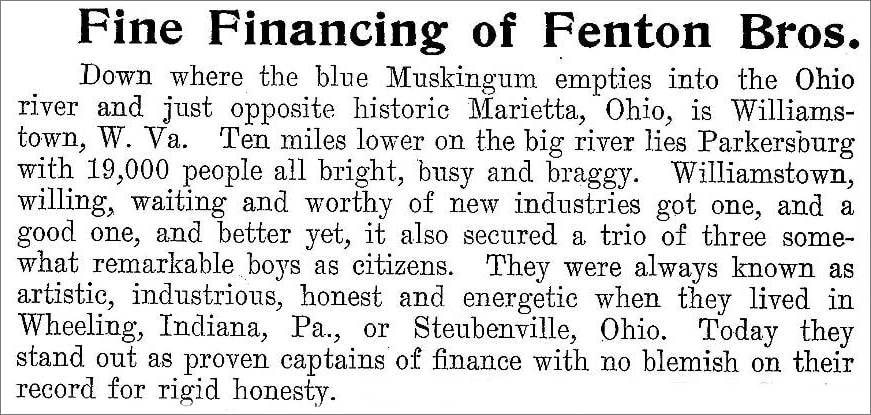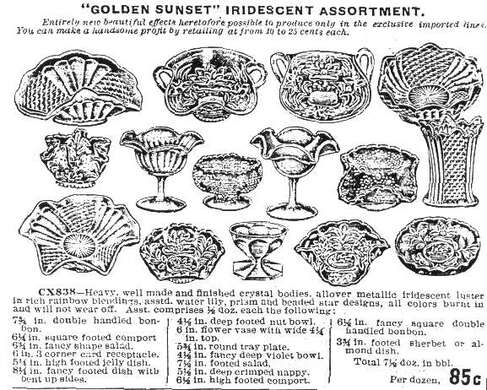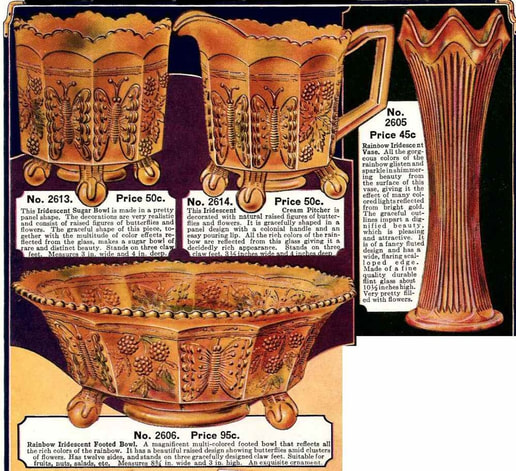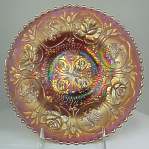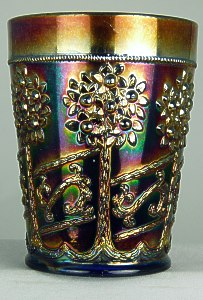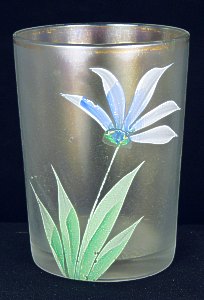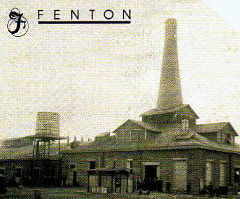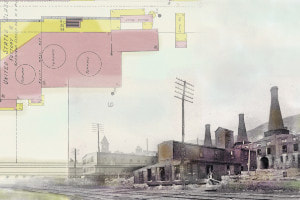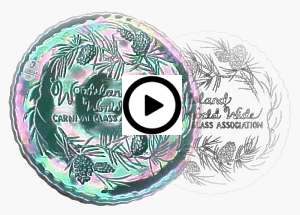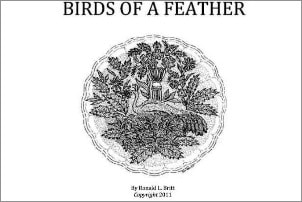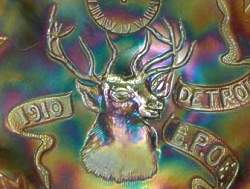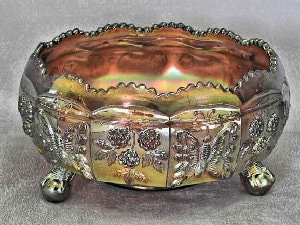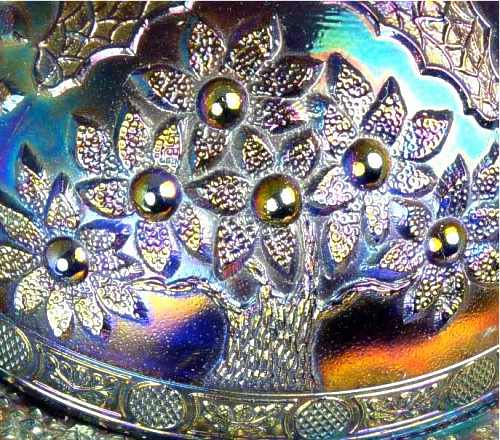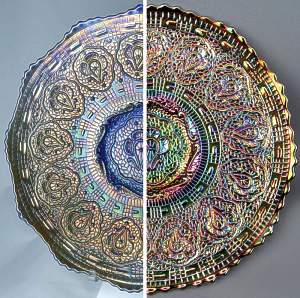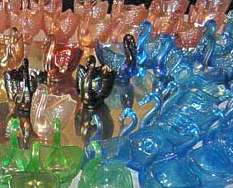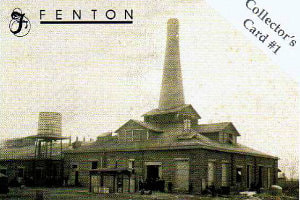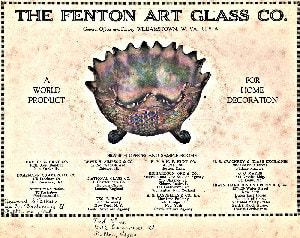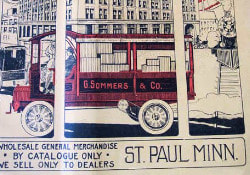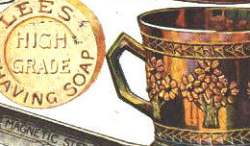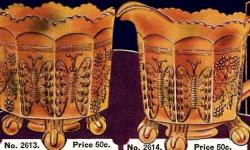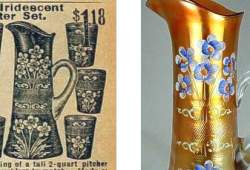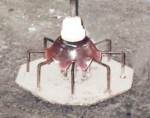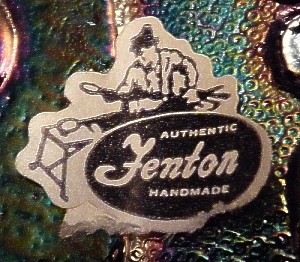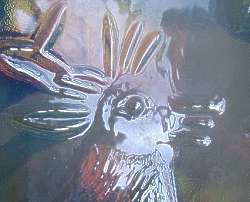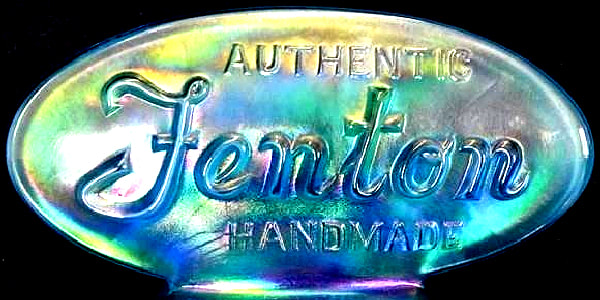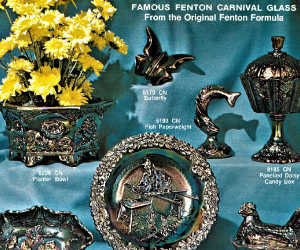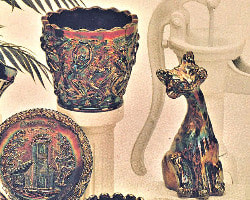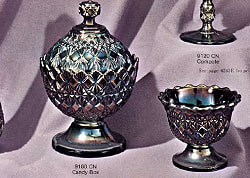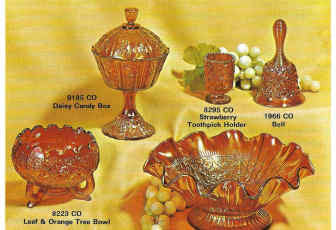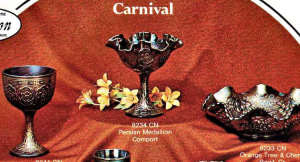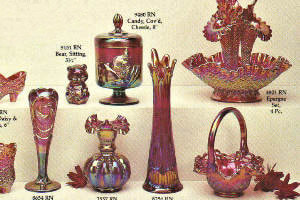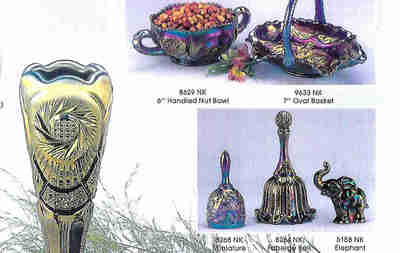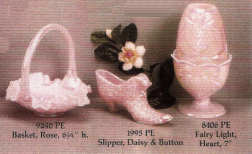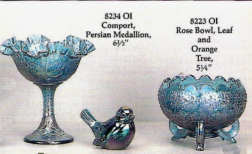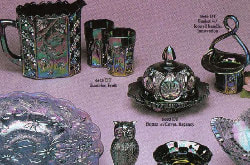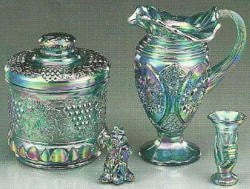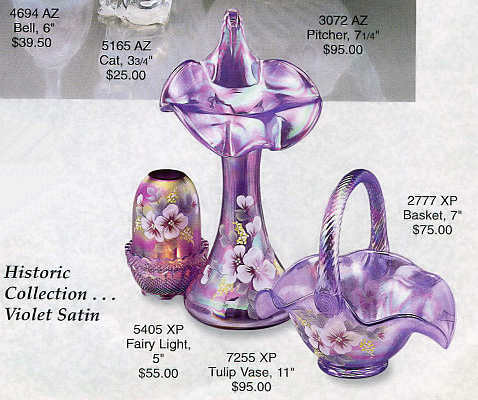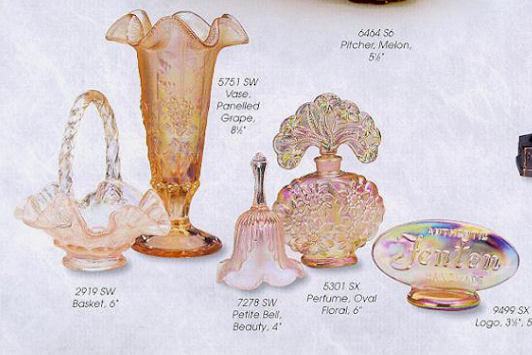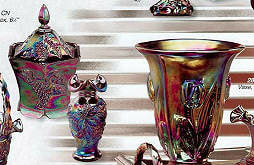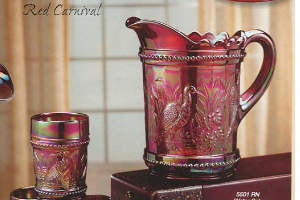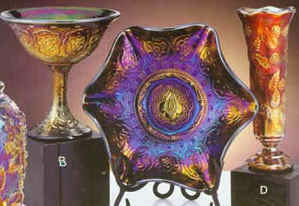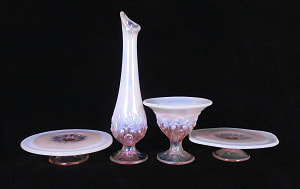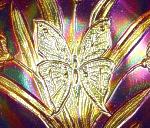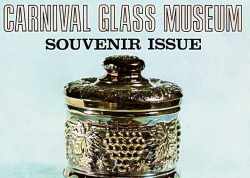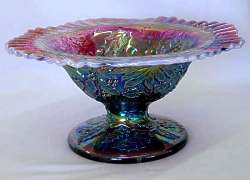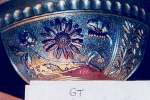Fenton (Williamstown, West Virginia)
Frank L. Fenton: “My particular work was in the matter of design and then I got the idea that if I could do this work for an employer, I could certainly do something for myself. So, with $284 capital, my brother John and I rented an old glass plant in Martins Ferry, Ohio, and went into the glass business for ourselves. That was back in 1905.” Frank was referring to how he, and his brother John W. Fenton initially established the Fenton Art Glass Company at Martins Ferry in 1905, before they moved to Williamstown, West Virginia in 1906-7.
Frank's words featured in a 1946 article by the “Parkersburg News” that profiled Frank L. Fenton and his Fenton glass company. The article described how Frank, aged fifteen, had started working for his uncle who ran a bakery and restaurant with an animal feed business “on the side”. Early in the morning Frank would hitch up “the old grey mare” and deliver feed for the animals. He described how he would spend the day delivering and then worked in the restaurant until 10 or 11 o’clock at night. After he graduated from high school, Frank got a job in the only industry in his little home town of Indiana – the Indiana glass plant. After three years there Frank moved in 1900 to Jefferson Glass in Steubenville, Ohio and then to Bastow Glass in Cowdersport, PA. When Bastow burned down, Frank went to work for Northwood at Wheeling. Here, he realised he could work for himself just as well.
Frank's words featured in a 1946 article by the “Parkersburg News” that profiled Frank L. Fenton and his Fenton glass company. The article described how Frank, aged fifteen, had started working for his uncle who ran a bakery and restaurant with an animal feed business “on the side”. Early in the morning Frank would hitch up “the old grey mare” and deliver feed for the animals. He described how he would spend the day delivering and then worked in the restaurant until 10 or 11 o’clock at night. After he graduated from high school, Frank got a job in the only industry in his little home town of Indiana – the Indiana glass plant. After three years there Frank moved in 1900 to Jefferson Glass in Steubenville, Ohio and then to Bastow Glass in Cowdersport, PA. When Bastow burned down, Frank went to work for Northwood at Wheeling. Here, he realised he could work for himself just as well.
|
We discovered a truly fascinating article written in 1907, and we first reported it to the Carnival Glass collecting world in our NetworK Issue #98 (July 2023). It explains that he start-up in Williamstown was welcomed by the local people, and how it was financed; essentially, land lots were sold often to “retired farmers, oil well operators and merchants”.
As the article explains: ”The wife of most purchasers received a gorgeously decorated water or lemonade set at a cost to the makers of less than fifty cents, but with the ladies happy, what investor would then hesitate about buying a $200 lot”. On the right is a short snippet from the article, and you can read it in full here: “Williamstown Welcomes Fenton, 1907”. |
|
Two patterns feature strongly in this first known Butler Brothers ad for Fenton's Carnival (September, 1908) - Diamond Point Columns, and Waterlily & Cattails.
|
Carnival Glass was not the first ware from the Fenton factory at Williamstown, but it is arguably the most famous. In 1907 Fenton was making glass reportedly called “iridie” or “iridill” that had a metallic lustre. In 1908, John Fenton left the Fenton company and he founded the Millersburg Glass Company. Also in 1908 Fenton had the first known trade ad for what we know as Carnival Glass - it is the one shown on the left for a “Golden Sunset Assortment” in the Butler Brothers catalogue, September 1908 issue. There cannot be many Carnival Glass collections around the world that don’t include an example of Fenton’s glass. Familiar patterns such Peacock & Grape, Dragon & Lotus and Diamond & Rib or their delightful “embroidery” designs like Persian Medallion and Captive Rose are loved and collected by many. Some unusual Fenton patterns and colours are found more often in certain countries. For example, the Peter Rabbit pattern seems to turn up in the UK as does the rare Fenton colour, celeste blue. Trade ads for Fenton’s Carnival also appeared in the British Pottery Gazette through to the 1920s; while in Australia, Fenton’s Carnival was on offer with coupons collected with Bushell’s Tea. |
|
The ad on the right comes from a Mail Order catalogue - a popular way of selling all sorts of household goods in the early 1900s: from hardware to pharmaceutical requirements to clothes, fine china and ..... yes, Carnival Glass!
You can read all about our feature of the role of the Mail Order businesses in selling and distributing Carnival Glass to the customers of the time. Check out our new unique feature: "Sell it to me!" This particular Carnival Glass assortment was on offer to customers of The Perry G. Mason Co., Cincinnati, Ohio, in around 1925. They were offered Butterfly and Berry (sugar, creamer and footed bowl) and a Fine Rib vase, all in marigold. In fact, Fenton’s Carnival became a familiar sight all over the world. They used marketing companies to distribute their glassware within the USA (such as Perry Mason, as well as Butler Brothers and Lee Manufacturing), and they also exported widely. In the UK, they were represented by a Mr Charles Pratt of the National Glass Co. - in itself a fascinating story that you can read here. Below is a 1928 list of “branch offices and sample rooms” that we found while researching at the Fenton factory in the mid 1990s:
|
|
USA
Horace Gray Co., New York City, Dohrmann Commercial Co., San Francisco, CA Howard Bokee and W.T. Owen, Baltimore, MD Lewis Simpson & Co., Chicago, IL Fred Kline, Dallas, TX H.P. & H.F. Hunt Co., Boston, MA U.S. Crockery & Glass Exchange, Philadelphia, PA C.C. Mayer, St. Louis, MO |
Elsewhere
National Glass Co., London, England Geo. B. Hall, New York, South American Agency Richardson, Orr & Co., Sydney, Australia Richardson, Orr & Co., Wellington, New Zealand A.S. Lascelles & Co., New York, South African Agency Also listed were: Dutch East Indies, Republic of China, Federated Malay States, British North Borneo and Straits Settlements. |
Classic Carnival Glass production by Fenton continued into the 1920s (in the early years of which they made their famed red Carnival), tailing off at the end of the decade.
Revival (Contemporary) Carnival Glass
In the 1970s, Fenton (like Imperial) re-introduced production of Carnival Glass often using their original moulds and also a massive range of entirely new and innovative patterns and shapes. Their Revival Carnival was clearly marked and you can read all about this in "Fenton Old and New". See “A Century of Carnival Glass” for further information and illustrations.
Sadly, Fenton Art Glass ceased traditional glassmaking at the Williamstown, WV factory in July 2011. However, a successor business, Fenton Gift Shops, Inc. took on various parts of the operation and assets, making handcrafted glass beads and teardrop earrings.
Fenton Gift Shops also acquired many of the assets of the closed Fenton factory, including the moulds, and Fenton Gift Shops is now contracting with other glass companies, such as Blenko, to use some of them for making Limited Edition items.
Read and See More about Fenton - click on any image.
